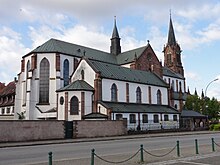This article has multiple issues. Please help improve it or discuss these issues on the talk page. (Learn how and when to remove these messages)
|
The Basilica of Notre-Dame, Marienthal (French: Basilique Notre-Dame de Marienthal), is a Roman Catholic pilgrimage church dedicated to the Blessed Virgin Mary. Located in Marienthal, in the Bas-Rhin department of France, it is administratively situated in the town of Haguenau.
| Basilica of Notre-Dame, Marienthal Basilique Notre-Dame de Marienthal | |
|---|---|
 | |
 | |
| 48°46′46.24″N 7°49′01.23″E / 48.7795111°N 7.8170083°E | |
| Location | Haguenau |
| Country | France |
| Denomination | Catholic |
| Website | http://basiliquemarienthal.fr/ |
| History | |
| Status | Minor basilica (since 1892) |
| Founded | 1250 |
| Founder(s) | Albert of Haguenau |
| Dedication | Mary, mother of Jesus |
| Architecture | |
| Functional status | Pilgrimage church |
| Architectural type | basilica |
| Style | Gothic Gothic Revival |
| Groundbreaking | 1863 |
| Completed | 1866 |
| Administration | |
| Archdiocese | Archdiocese of Strasbourg |
| Parish | paroisse Saint Joseph de Marienthal |
Pope Pius IX crowned the dolorous Marian image enshrined within in 19 September 1859. Pope Leo XIII elevated the status of the shrine to Minor basilica in 31 May 1892.[1]
The first sanctuary at this site was built around 1250 by the knight Albert of Haguenau (died in 1254), who had had a religious epiphany some ten years prior and had gathered a small community of faithful around him. This first sanctuary, called "Mary in the Valley", venerated a statue of the Madonna and Child which is not preserved today.[2] The two statues that are venerated today, a Madonna and Child and a Pietà, date from the early 15th century.[3] In the 18th century, the basilica also received precious gifts from queen consort Marie Leszczyńska.[4]
The current, spacious church was built in 1863–1866 in the Gothic Revival style, but keeps a Late Gothic sacristy from 1519, decorated with early Renaissance bosses, and elaborate works of art such as a Dormition of Virgin Mary, and an Entombment of Christ, carved in sandstone by the local master sculptor, Friedrich Hammer (also known as Fritz Hammer, or Frédéric Hammer).[5] Among the 19th-century works of art in the basilica figures a set of frescoes by Martin von Feuerstein (1889).[6]
Gallery
edit-
West facade
-
Interior, looking east
-
Interior, looking west
-
Madonna and Child
-
Pietà (Canonically Crowned, 19 September 1859, PP. Pius IX)
See also
editReferences
edit- ^ "9. XIXe : un siècle de gloire". basiliquemarienthal.fr. Retrieved 14 May 2019.
- ^ "1. Albert de Haguenau, fondateur de " Mariæ in valle "". basiliquemarienthal.fr/. Retrieved 14 May 2019.
- ^ "3. Début du XVème siècle : origine des 2 statues de la Vierge". basiliquemarienthal.fr. Retrieved 14 May 2019.
- ^ "7. Maria Leszinska, reine de France : sa dévotion à Notre-Dame de Marienthal". basiliquemarienthal.fr. Retrieved 14 May 2019.
- ^ "2. 1257-1543 : une communauté de moines guillelmites dynamiques". basiliquemarienthal.fr. Retrieved 14 May 2019.
- ^ "La basilique Notre-Dame-des-Douleurs de Marienthal à MARIENTHAL (67)". petit-patrimoine.com. Retrieved 14 May 2019.